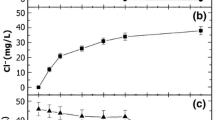Abstract
The degradation of 4-chlorophenol (4-CP) by using gamma rays generated by a 60Co source in the presence of O3 was investigated. The radiolysis of 4-CP and the kinetics of 4-CP mineralization were analyzed based on the determination of total organic carbon (TOC). The influence of initial 4-CP concentration and the free radicals scavengers (such as NaHCO3 and t-butanol) on the 4-CP degradation was also studied. The results showed that when the radiation rate was 336 Gy·min−1, 4-chlorophenol at concentration of 10 mg·L−1 could be completely degraded at the radiation dose of 2 kGy. The degradation of 4-chlorophenol could be described by a first-order reaction model, the rate constant of 4-CP degradation by combined ozonation and radiation was 0.1016 min−1, which was 2.4 times higher than the sum of radiation (0.0294 min−1) and ozonation (0.0137 min−1). It revealed that the combination of radiation and ozonation resulted in synergistic effect, which can remarkably increase the degradation efficiency of 4-CP.
Similar content being viewed by others
References
Wang, J. L., Microbial Immobilization Techniques and Water Pollution Control, Beijing: Science Press, 2002, 261–271.
Wang, J. L., Horan, N., Stentiford, E. et al., Biosorption of pentachlorophenol (PCP) from aqueous solution by activated sludge biomass, Bioresource Technology, 2000, 75: 157–161.
Wang, J. L., Qian, Y., Microbial degradation of 4-chlorophenol by microorganisms entrapped in carrageenan-chitosan gels, Chemosphere, 1999, 38: 3109–3114.
Wang, J. L., Werner, H., Microbial dechlorination of trichlorophenol by a bacterial consortium: Characterization and mechanisms, Science in China, Series B, 2003, 46(2): 207–215.
Quan, X. C., Shi, H. C., Wang, J. L. et al., Treatment of chlorophenol contaminated wastewater using sequencing batch reactors supplemented with immobilized chlorophenol-degrading bacteria, China Environmental Science (in Chinese), 2002, 22: 132–136.
Hu, J., Wang, J. L., Radiation-induced degradation of chlorophenols in aqueous solution, J. Radiat. Res. Radiat. Process, 2005, 23: 135–139.
Schmid, S., Krajnik, P., Quint, R. M. et al., Degradation of monochlorophenols by γ-irradiation, Radiat. Phys. Chem., 1997, 50: 493–502.
Zona, R., Detoxification of aqueous chlorophenol solutions by ionizing radiation, Wat. Res., 1999, 33: 1314–1319.
He, Y., Liu, J., Lu, Y. et al., Gamma radiation treatment of pentachlorophenol, 2,4-dichlorophenol and 2-chlorophenol in water, Radiat. Phys. Chem., 2002, 65: 565–570.
Getoff, N., Factors influencing the efficiency of radiation-induced degradation of water pollutants, Radiat. Phys. Chem., 2002, 65: 437–446.
Wu, J. L., Qi, S. C., Radiation Chemistry, Beijing: Atomic Energy Press, 1991, 10–45.
Wu, M. H., Bao, B. R., Radiation Technology Application in Environmental Protection, Beijing: Chemical Industry Press, 2002, 34–190.
Trojanowicz, M., Drzewicz, P., Panta, P. et al., Radiolytic degradation and toxicity changes in g-irradiated solutions of 2,4-dichlorophenol, Radiat. Phys. Chem., 2002, 65: 357–366.
Elizardo, F., Fighting pollution with hydrogen peroxide, J. Pollut. Eng., 1991, 106–109.
Gehringer, P., Eschweiler, H., Ozone/electron beam process for water treatment: Design, limitations and economic considerations, Ozone Sci. Eng., 1999, 21: 523–537.
Hart, E. J., Sehested, K., Bjergbakke, E., Holcman, J., Gamma-ray initiated decomposition of aqueous ozone solutions, Radiat. Phys. Chem., 1987, 29: 399–403.
Getoff, N., Lutz, W., Radiation induced decomposition of hydrocarbons in water resources, Radiat. Phys. Chem., 1985, 25: 21–26.
Drzewicz, P., Trojanowicz, M., Zona, R. et al., Decomposition of 2,4-dichlorophenoxyacetic acid by ozonation, ionizing radiation as well as ozonation combined with ionizing radiation, Radiat. Phys. Chem., 2004, 69: 281–287.
Author information
Authors and Affiliations
Corresponding author
Rights and permissions
About this article
Cite this article
Hu, J., Wang, J. & Chen, R. Degradation of 4-chlorophenol in aqueous solution by γ-radiation and ozone oxidation. SCI CHINA SER B 49, 186–192 (2006). https://doi.org/10.1007/s11426-006-0186-y
Received:
Accepted:
Published:
Issue Date:
DOI: https://doi.org/10.1007/s11426-006-0186-y




